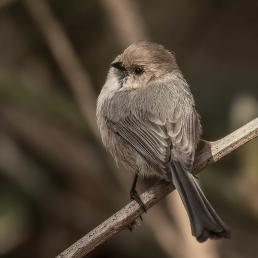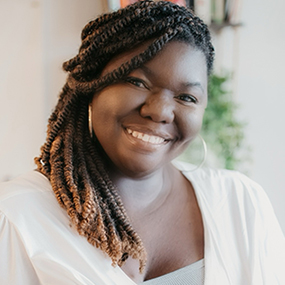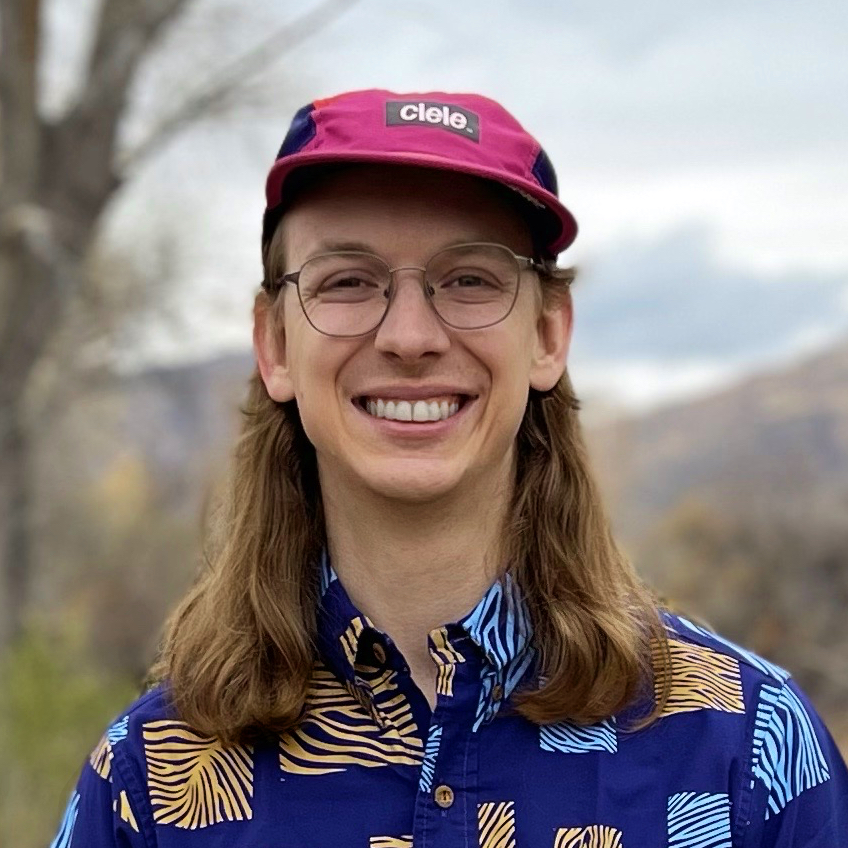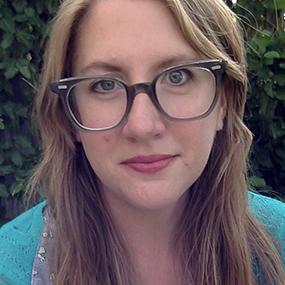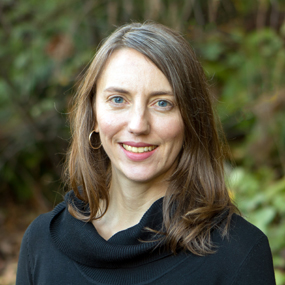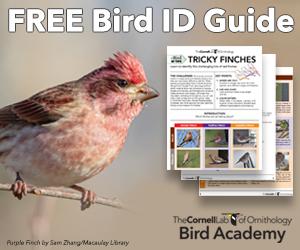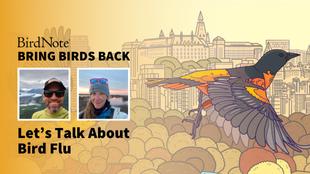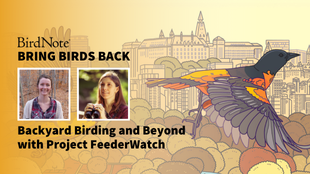

Join BirdNote tomorrow, November 30th!
Illustrator David Sibley and actor H. Jon Benjamin will face off in the bird illustration battle of the century during BirdNote's Year-end Celebration and Auction!
The second of this two-part segment pulls apart the issues with cats and birds. Host Tenijah Hamilton gets an overview of how outdoor cats affect bird populations, why it’s such a controversial issue, and what’s to be done about it. She discusses this with producer Mark Bramhill and guests including Karen Krauss, and Joe Liebezeit.
Tenijah Hamilton: BirdNote Presents.
From BirdNote, this is Bring Birds Back. I’m Tenijah Hamilton. Today we are continuing our look at birds and cats. We’re joined again by Mark Bramhill, producer for Bring Birds Back.
Mark Bramhill: Hey Tenijah, great to be here.
Tenijah Hamilton: Great to have you back. I mean, you’re almost always here anyway. But it is a fun time to have you up front. I already learned so much from you last episode.
Mark Bramhill: Let’s see what you remember. Kinda, talk it back to me.
Tenijah Hamilton: Alright, so I remember the number of birds that are killed by cats in North America each year is a truly astronomical number. I want to say somewhere between, like, 1 to 4 billion birds?
Mark Bramhill: Yup, that is exactly it. 1.3-4 billion birds killed by cats in North America every year
Tenijah Hamilton: Oof, that is many a bird, many a bird. So we also talked about how keeping cats indoors can make a huge difference in helping birds. Especially when birds are especially vulnerable. So thinking about dawn and dusk. Thinking about little fledglings out in spring. And we can have an impact if we just keep our little cat friends indoors.
Mark Bramhill: Exactly. Fledglings are friends not food.
Tenijah Hamilton: When the Bring Birds Back merch comes out…
Mark Bramhill: I’m gonna get that on a tote bag, yeah.
Tenijah Hamilton: And then we talked about how to give your cat a great life indoors so that everyone really wins. And that included talking about all the exercise that you can do with your cat. Setting up kind of like, bird-per-view, pay-per-view for birds, where the cats sit at the window.
Mark Bramhill: Yup, yup, some good cat tv. Yeah.
Tenijah Hamilton: There we go, same concept. Same concept. And then, the last bit was that, uh, the best cat representation that we have in this day and age is Dame Judi Dench as Old Duetornomy in 2019’s spectacular smash, Cats. And that single-handedly saved the birds.
Mark Bramhill: You know, I don't think that one was in there.
Tenijah Hamilton: I think it was.
Mark Bramhill: And if you haven’t listened to our last episode, maybe do that first.
But yeah, we can’t really talk about this issue about cats and birds, without addressing a pretty large group, which is feral and stray cats. Colonies of cats without homes. In some cities and places, they’re more obvious, but there are an estimated 30-80 million of them in the US. It’s a lot of cats!
Tenijah Hamilton: That is a lot of cats. And you know, it really makes sense when you think about it because feral cats, they don’t have an owner to maybe keep them inside. They can hunt anytime, and they need to hunt birds and other animals to eat. So yeah I can imagine they are a pretty big contributor to this problem.
Mark Bramhill: They actually make up the majority of those bird deaths. But, while the pet cat issue can get heated, the feral cats are where things get, well, wild. Most cat and bird people aren’t willing to have a real conversation about it. But not everyone is like that...
Bob Sallinger: Uh, I do have a pet cat. My pet cat is named Badger and is sitting about 10 feet from me.
Mark Bramhill: This is Bob Sallinger.
Bob Sallinger: I'm the conservation director for the Portland Audubon society. And I've worked for Audubon for about 30 years.
Tenijah Hamilton: I’m going to assume that he’s more of a bird guy?
Mark Bramhill: He is! But he also loves cats, and he’s been interested in this issue since the early 90s, when he joined Audubon.
He was working in the wildlife care center, where they tried to help injured birds recover. And about 40% of their intakes were cat related. And he would talk to people bringing in these birds about keeping their cats indoors. But it just wasn’t connecting with people.
Bob Sallinger: And I found that very interesting because, the people that were coming to us clearly cared about animals, cared about birds, were willing to drive a half an hour to bring us a bird that their cat had caught, but yet weren't willing to take the next step.
Tenijah Hamilton: That is really interesting. It’s evident that they cared, but there’s still something missing to connect the dots to make them take the next step.
Mark Bramhill: Yeah. And as Bob saw more and more birds injured by cats, he started to question the approach they’ve had. And looked into kind of the history of how they had approached the issue.
Bob Sallinger: I could go back into our archives and see writings by our founder, William Finley, talking about the problems of cats and cat predation, dating back to the early 1900s. Lethal control and telling people to keep their cats indoors have been the dominant strategies for a century, yet today we have more free roaming cats in the United States than any time in our history. I was frustrated with the degree to which I felt we were singularly ineffective on this issue. So I was looking for a different strategy.
Tenijah Hamilton: OK, so what strategies are there for dealing with feral cats? What are the options Bob has here?
Mark Bramhill: Yeah, so as he mentioned, the standard approach for bird organizations has been kind of scolding people to keep their pet cats inside, and pushing for euthanizing lots of feral cats. Not super popular options!
Tenijah Hamilton: Can we adopt these cats? These feral cats, can we just bring them indoors?
Mark Bramhill: It’s definitely the first thing to try. But adopting all of them out isn’t possible. When these feral cats grow up, they’re usually set in their ways and not suitable for life with people. They’re essentially wild cats at that point.
Tenijah Hamilton: Alright, we can adopt out the little baby kittens and the friendly and approachable adults. Correct me if I’m wrong but it seems that there’s still a big gap right there. Like there’s a lot of cats that we’re leaving out of the equation.
Mark Bramhill: Still a lot of cats that are out there, yup. There’s some other approaches. One is these programs adopting feral cats out as quote, “working cats”, to live on farms or in warehouses to hunt. There are questions about how good they are at killing the actual pests rather than wildlife. But even in the best cases, they’re still usually outside and able to kill birds.
Tenijah Hamilton: So what does that leave us with?
Mark Bramhill: Well that brings us to a really controversial approach that many cat people have rallied behind. It’s called T-N-R, or trap, neuter, return. I spoke to Karen Krauss, executive director of the Feral Cat Coalition of Oregon about this.
Karen Krauss: We provide humane live traps and the people will trap feral cats, bring them to us for spay, neuter, and vaccinations, and then they'll return them to where they're being fed. Thus trap, neuter, return.
Mark Bramhill: It’s a compelling idea: if the cats can’t reproduce, the feral colonies will slowly shrink and disappear. That’s what drew Karen to TNR in the 90s.
Karen Krauss: I had volunteered at an animal shelter in the Midwest where feral cats were euthanized. That seemed, you know, in the early nineties, as I guess what just happened to feral cats and I moved to Oregon and I saw this group and I saw it on the news and I thought, "Oh my gosh, there's an alternative. There's help for them!"'
Tenijah Hamilton: So this feels like everyone wins… but if it’s controversial, I’m guessing there is more to it.
Mark Bramhill: There is definitely more to it. You know, these cats are still out in the environment for the rest of their lives, killing birds and wildlife. And it’s very hard to make the math work. Studies have shown you need around 75-90% of the feral cats in a colony to be sterilized to actually see the population decrease. And that’s really hard to do. And — you remember Dr. Pete Marra from last episode?
Tenijah Hamilton: Yeah, I do. He had Tookus. Tookus was his cat. And he did research and he’s the one who found the really huge numbers.
Mark Bramhill: Exactly. Well, this is an issue that Marra is pretty passionate about — he and many bird people really see only one way forward, and that is euthanizing millions of these cats:
Peter Marra: Humane euthanasia is an unfortunate outcome, but the harsh reality of the situation is, I don't want those cats killing an oven bird. I don't want those cats killing a Townsend or a Towhee. And that's what they'll do. And so it's not an easy solution to come to. But I don't really see another solution. Do you?
Tenijah Hamilton: But Pete!?What about Tookus?
Mark Bramhill: What about Tookus, Pete?
Tenijah Hamilton: He’s saying that to save one species, we have to kind of cull another. I don’t know, I can see why people might be uncomfortable with that.
Mark Bramhill: Yeah, and so we have cat advocates pushing for TNR or bust, that this is going to be the solution that saves us. And bird advocates like Peter Marra who are unwilling to even talk about it really. It’s just a lot of real anger and mistrust from both sides. And we get stuck in these echo chambers.
But this is where we come back to Bob and Portland Audubon. It’s the 90s, he’s out looking for a way to actually get through to people. And he hears about Karen Krauss and this new organization in another part of the city: the Feral Cat Coalition of Oregon
Bob Sallinger: I first really heard about them cause the media started calling me up and saying, you know, say something bad about them. You know, there was this expectation that the cat advocates and the bird advocates would be at each other's throats. I didn't take the bait. Instead I went to their website, I looked at their mission and I was struck by how similar the language was. They wanted people to keep their cats indoors, to reduce free roaming cats in the environment. Cause that was one of the primary sources of feral cats and the population problem they were trying to deal with. So I reached out, I asked for a meeting and I said, you know, I'd love to get together and see if we have any common ground. And I was pleased that Karen reached back.
Karen Krauss: It was barely even a discussion.You're protecting the environment, we're trying to help the cats, but we clearly have an overlap. So yeah, of course, we were more than happy to sign up for that. And that was really the start of it.
Mark Bramhill: The two organizations partnered up, beginning by signing a joint letter in support of keeping cats indoors.
Tenijah Hamilton: I mean, everybody has to start somewhere. But is a joint letter really that big of a deal? Does it change anything at all?
Mark Bramhill: Well you’re right, it’s absolutely more symbolic. But the fact that these organizations were collaborating on anything was really unusual. And their partnership has deepened over time. They’ve worked together on policies and approaches to decrease feral populations. And that has included the bird world heresy of embracing TNR.
Bob Sallinger: I think the conservation community has made an error here in the sense that it's treated TNR as an existential threat, rather than as a tool in the toolbox. If you spend all your time bickering over this one tool in the toolbox it's very hard to make progress on the overall issue.
Tenijah Hamilton: Wow, that does seem like a leap of faith for the bird people.
Mark Bramhill: It really is! And the significance of that openness isn’t lost on Karen.
Karen Krauss: When you want a partner and you ask the conservation groups to accept trap neuter return, they're giving, right? They're out on a limb, giving. Believing. And so I think animal welfare groups need to give a little too.
Mark Bramhill: One example of compromise from the Feral Cat Coalition is, once feral cats are sterilized they aren’t returned to important wildlife areas, in order to reduce pressure on bird hotspots. By partnering with the Feral Cat Coalition, Portland Audubon has a seat at the table. The organizations have worked together and looked for ways their missions overlap — and one part of that has been working together on this big TNR project. And after the break we’re going to go to an island of feral cats to understand how that has all been working.
Tenijah Hamilton: Mark Bramhill, you got to spend time at the cat island?!
Mark Bramhill: Yep! That’s after this.
[MIDROLL AD]
Tenijah Hamilton: OK, so the Feral Cat Coalition and Portland Audubon have been working together to find common ground solutions to protect birds and feral cats… and you said part of that takes place on an island of feral cats? Please say more.
Mark Bramhill: Haha yeah, so that brings us to the Hayden Island project
Joe Liebezeit: All right. Um, thank you guys all for coming today.
Mark Bramhill: Hayden Island is located just north of Portland in the Columbia River. It’s about, it’s pretty small, about a total of 1.7 square miles. Half of the island is undeveloped natural area. The rest is kind of residential. Just about 2,000 people live there. But they’re not alone. There are also about 400-500 feral cats that also call Hayden Island home.
Tenijah Hamilton: It’s like a cat playground!
Mark Bramhill: Yeah, it’s an island of cats. Joe Liebezeit of Portland Audubon leads a research project on these cats, and last Fall I was able to tag along for their annual “cat count” of the island.
Joe Liebezeit: A key part of the project is having you guys, community scientists go out into the field and count the cats. Unlike a lot of bird projects where you have to identify all kinds of different birds, it's pretty easy to identify a cat, right?
Tenijah Hamilton: We love a good community science project!
Mark Bramhill: For sure! So three times each September, Joe and a bunch of volunteers get together to tally up the island’s cat population.
Tenijah Hamilton: And what are they trying to understand from this study?
Mark Bramhill: Yeah, they want to know basically how the population control strategies are — or are not — working.
Studying and tracking TNR has been kind of difficult to do in the past. A big part of that is because most of the time the cat groups that are doing TNR don’t trust the bird researchers not to come in and vilify cats. It’s really something which is only possible because of the trust that these organizations have together. When I went with Joe for this community science project, you know, the volunteers include cat fanatics and avid birders, and people everywhere in between. And everyone is really excited to be part of this. They’re all excited to work together. We broke into groups to kind of survey different parts of the island, and I tagged along with Joe and his kids Petra and Griffin. And we went through this manufactured home community. Pretty much right away.
Petra: There's one!
Mark Bramhill: We saw some cats.
Joe Liebezeit: Where?
Petra: Right here! Grey, uh, no eartip.
Tenijah Hamilton: And how cool is it to have this project where all these different people, all these different ages. I mean I hear this little girl going “No eartip!” Mark what’s an eartip? What does that even mean?
Mark Bramhill: So when they're spayed or neutered, many of these organization will cut of a tiny bit of the ear tip so that it’s got a noticeable marker that this cat’s already been brought in. So if we catch it again, we can just release it and call it a day.
Tenijah Hamilton: Got it.
Mark Bramhill: And so it allows for knowing, alright that’s a cat but we’ve already seen him before. They also note the color of the cat, if it has a collar, if it’s visibly pregnant, and if they know that it’s a pet cat.
Joe Liebezeit: So look now he's approaching. definitely a social one. Yeah. Can you see an ear tip? I don't think I see one, but let's take a close look. Nope. He looks intact. Is that a Calico? Torti?
Mark Bramhill: …sometimes the pets are kinda obvious. You can probably tell from that guy’s little meow. He was just coming right up like “alright, I’m ready for some pets. I’m here”. Just a little bit of a strut.
Joe Liebezeit: Little bit further up here?
Griffin: Uh, yeah. It was just crossing the street.
Joe Liebezeit: Okay.
Griffin: Black and white.
Joe Liebezeit: It looks like he’s an older cat cause his ear is a little ripped up. Which makes it tricky to tell if it’s got a tipped ear.
Joe Liebezeit: Does that one have a collar?
Petra: No collar!
Joe Liebezeit: Okay.
Petra: I'm not sure if he has an ear tip. I thought he had one.
Joe Liebezeit: It doesn't. I can tell it doesn't
Petra: Like his ears are kind of rounded anyway.
Mark Bramhill: It was just so, so many cats.
Tenijah Hamilton: So many cats.
Joe Liebezeit: Hey look guys up in the sky. There's uh, two, uh, Sandhill cranes flying above us. Two Sandhill Cranes. Hey, I can switch to birding. Okay. It’s okay. I can do, I can count cats and I can look up in the sky and see cranes.
Tenijah Hamilton: I love that. It seems like the kids are like, “look sir, one track mind please. We’re here for the cats.” And Joe kind of has a problem staying away from the birding.
Mark Bramhill: Yup. We’re all here for the cats, but Joe’s a bird guy at heart.
Joe Liebezeit: That's a great sighting guys, Sandhill Cranes. You don't see them every day.
Mark Bramhill: As we walk around this neighborhood, between cat sightings, I ask Joe about their study results. They’ve been doing TNR on this island for around 7 years and the population has stayed relatively stable, though it’s trending slightly downwards.
The group estimates that half the feral cats here have been sterilized, and that percentage is rising. But that is very far from the 75 to 90% found to be effective in other studies.
Tenijah Hamilton: Yeah, not quite there yet, huh?
Mark Bramhill: Not quite, not quite there.
As we approach the end of our route, Joe tallies up the cats we’ve seen:
Joe Liebezeit: Let's see, we got one, two, three, four, five, six, seven, eight, nine, 10, 11, 12, 13, 14, 15, 16, 17, 18, 19, 20...
Mark Bramhill: We’ve walked about a half mile down three streets in this neighborhood. That’s a lot of cats.
Joe Liebezeit: 21, 22, 23 in three streets, 23 cats. And we, we know that we're, we don't see every cat, obviously.
Mark Bramhill: So yeah, that’s uh...
Tenijah Hamilton: That is a very large number for that little ground covered.
Mark Bramhill: It really is! And many of the cats we saw today hadn’t been sterilized. Clearly, TNR alone is not going to magically solve everything. But that also doesn’t mean that this has necessarily been a failure.
Tenijah Hamilton: How's that?
Mark Bramhill: Well, by embracing TNR, Portland Audubon has been able to work together with the Feral Cat Coalition. And that has led to concrete steps to actually move the needle.
The Feral Cat Coalition offers spay and neuter services to anyone for a suggested donation, but it’s free for those who need it. They treat around 7,000 cats a year, and recently fixed their 110,000th cat. They do research projects like this one on Hayden Island. And while euthenasia isn’t a huge part of their efforts, both organizations are committed to keeping it available when needed.
Tenijah Hamilton: Are other people skeptical of this partnership?
Mark Bramhill: Oh absolutely, they’ve heard from plenty of naysayers.
Tenijah Hamilton: I thought they might.
Bob Sallinger: On both sides of this issue, outside groups were very, very concerned that if the feral cat coalition worked with Portland Audubon, that it would be a slippery slope toward rounding up cats and killing them on a large scale in Portland. And conversely, I think a lot of bird groups felt that if we work with the feral cat coalition, Portland would become the epicenter of protected, free roaming cats.
Mark Bramhill: But that hasn’t happened. It’s not just the folks at Portland Audubon that are giving a little bit. The Feral Cat Coalition is just as protective of that approach as Audubon.
Tenijah Hamilton: Yeah. It’s kind of just charming and - two sides coming together for the greater good. Yeah, it is pretty heartening.
Mark Bramhill: Here’s the thing: that’s about as good as things get in the world of birds and feral cats. A good-faith effort with cat people and bird people trying to solve it is a success story. It’s important to talk about this side of the cats problem, but I want to end our two-parter on a high-note, something positive and really promising for listeners — and Portland Audubon and the Feral Cat Coalition have a project that perfectly fits the bill. They’ve taken the platform the two organizations have with cat lovers and used it to actually convince some of them to keep their pet cats inside. They’re making real headway on the pet-side of the problem, where we actually have a real, good answer.
Tenijah Hamilton: Well, what’re they doing that’s different from what Audubon has done in the past? Why is this resonating when what Bob saw in the past didn’t click?
Mark Bramhill: It all has to do with fun. In the 90s, enclosed outdoor spaces for cats — known as catios, like a cat-patio? You know?
Tenijah Hamilton: Oh yeah. Definitely, I see what they did there.
Mark Bramhill: They were an emerging trend in Portland, because, well, Portland.
And Karen came to Bob with this idea of doing the “Portland Catio Tour”
Bob Sallinger: and she said, um, Portland's really famous for its tours.
Karen Krauss: Be it a chicken coop or environmentally designed homes. There's all sorts of tours and people really enjoy them. So why not a catio tour?
Bob Sallinger: And I said, you know, that sounds like fun. Uh, I didn't think it would be hugely successful, but I thought it would be a cool thing to do. And let's give it a try.
Karen Krauss: We weren't sure what the result would be, but it seemed like a great way to show people an alternative.
Mark Bramhill: I feel like there was a little bit of a difference in confidence level around that but…
Tenijah Hamilton: Yeah, for good reason. For very good reason.
Bob Sallinger: That first tour. Uh, we were hoping to get a couple of hundred people. We had to cut off registration at 602 weeks before the event. Uh, Today, uh, seven, eight years later, we're getting 13, 1400 people coming out for it and having to cut off registration a couple of weeks before the event, I'm getting people calling me up the day of the event, begging for tickets. You know, people call up like they're rolling stones tickets and saying, yeah, you know, I don't know you, but a friend of mine gave me your phone number and they said, you might have an inside line. Uh, it's huge.
Tenijah Hamilton: Well that seems like a time.
Mark Bramhill: Yeah, and on this tour, you get to see some of the Portland area’s more than 600 catios, which just seems like such a blast, you know?
Tenijah Hamilton: 600 catios?
Mark Bramhill: Yeah, and they really run the gambit.
Bob Sallinger: all kinds of unique catios. Um, From, you know, the $150 do it yourself job to these incredibly elaborate catios that are nicer than my house.
Karen Krauss: And I think that's one of the takeaways for folks is it doesn't have to be elaborate.
Tenijah Hamilton: OK, well this all sounds like a blast, it sounds so fun — but… besides this fun part, what impact does a tour like this actually have?
Mark Bramhill: Yeah, it’s something where it seems like it might just be this silly thing, but it’s actually really made an impact on people keeping their cats inside.
Karen Krauss: What we're seeing is that we are getting the change that we were seeking. People go on the tour and they go home and they build a catio and then a year or two later, they want to be on the tour.
Bob Sallinger: Here's this really fun thing that somebody is doing that, you know, by the way it protects their cat, it protects the birds. It's good for the environment and, you know, look how cool this thing is. People having catios, it's just becoming normalized.
Tenijah Hamilton: So you know, something that kind of sticks out to me is, as I have been getting a little deeper into this world where we talk about cats and our big numbers and conservation and generally science communication, how we talk about these things to people.
Something that is very clear to me is that you can’t be a jerk about it and then expect people to want to do good things. And this is you know, something I’ve heard time and time again from my very good friend, Rey Maktoufi. She has a PHD in scientific misinformation. And she always says that to reach people, kind of reach across the aisle and say, like “hey!”, maybe you should consider this thing that you normally wouldn’t consider. It takes a lot of empathy. You’re not going to convince people to keep their cats indoors by making them feel like terrible people, and like a bad cat owner.
Mark Bramhill: Yeah. These cat owners really love their pets. They want to do the best. And this way feels so obvious once you hear it, but by making having an indoor cat fun and quirky and appealing, with like, a catio or taking them for a walk, or doing these things. Like, suddenly it’s this enticing, exciting-to-talk-about thing, where you’re luring people in with something they want to do.
Tenijah Hamilton: They’re a little quirky but that’s the point, right? Like it’s, the quirkiness isn't a byproduct, it’s more of like, yes, it needs to be these quirky, really cool new ways to show how we can make this exciting for all. And if we keep some of our pet cats indoors, if we spay and neuter others, and if we improve support for low income pet owners, we can make a massive impact here.
Mark Bramhill: Absolutely, like it would be great if we could go from 4 billion to zero overnight, but if we can make real progress on the pet cat front, we don't have to solve everything at once. And kind of what I’ve found is that when we’re both fighting, both cats and birds lose. Like no one, no one is winning when we come at each other with such animosity. It’s just…
Tenijah Hamilton: Nobody’s thriving here.
Mark Bramhill: Yeah, it’s a thing where, you know, when I’ve gotten to see see these cats living it up on their catios, or taking Pigeon out on a walk, it’s a reminder that what’s right for birds and what’s right for cats is possible. And it is totally worth it.
Tenijah Hamilton: Thanks for coming on to share all of this and your love of cats that could not possibly be contained in just two mere episodes. But we felt it. We feel it.
Mark Bramhill: Thank you for having me on Tenijah, I had an absolute blast!
Tenijah Hamilton: Bring Birds Back is produced by Mark Bramhill and me, Tenijah Hamilton. Today’s episode was edited by Oluwakemi Aladesuyi of Rough Cut Collective and by Ashley Ahearn. Our content director is Allison Wilson. Our lead science advisor is Trina Bayard. Music is by Cosmo Sheldrake and Blue Dot Sessions. Special thanks to Conor Gearin and Reka Murthy.
And thanks to our season sponsor, the Cornell Lab of Ornithology. Check out all they have to offer, like Bird Academy online courses and the Merlin ID app, at ALL ABOUT BIRDS DOT ORG.
Thanks for listening — see ya next time.
Mark Bramhill: Catios and some people taking their cats for walks or on adventures, like there’s a reason they go viral on Instagram and Tik Tok. Like, they’re exciting. They’re fun to look at and think like, “well what if I did that with my cat”. Like that would be a fun thing that I can do with Pigeon or someone could do with their little fluffy buddy.
Tenijah Hamilton: Yeah, Absolutely. Like, I’m not just a cat mom, I’m a cool cat mom, you know?
Mark Bramhill: Amy Poehler is just hanging out with her cat on a leash, you know?
Tenijah Hamilton: I know, I want my Pink Velour Sweatsuit and my camcorder.
Bring Birds Back is sponsored by the Cornell Lab of Ornithology.
About guest Bob Sallinger:
Bob has worked for Portland Audubon since 1992 and currently serves as Director of Conservation. His responsibilities include directing Portland Audubon’s conservation policy initiatives, wildlife research initiatives, Backyard Habitat Certification Program, and Wildlife Care Center. Bob’s passion for conservation was developed early exploring the woods of Massachusetts and later on solo hikes from Mexico to Canada on the Pacific Crest Trail and from Canada to Southern Colorado on the Continental Divide. Bob has a B.A. in Biology from Reed College and a J.D. from Lewis and Clark Law School. He currently serves as board president of Humane Oregon and on the board of the Intertwine Alliance. He previously worked as an adjunct professor of law at Lewis and Clark Law School and as an elected director at East Multnomah Soil and Water Conservation District. He lives in Northeast Portland with his wife Elisabeth Neely, three children and an assortment of dogs, goats, chickens, cat and other critters.
About guest Karen Krauss:
Karen has been with the Feral Cat Coalition of Oregon since 1995, the founding year. She served as a volunteer, board member and became the first paid staff member in 1997. In 2002 she was named Executive Director. In Karen’s tenure, FCCO has grown from spaying/neutering 1,500 cats per year to helping more than 7,000 cats per year today, and overall FCCO has performed more than 110,000 spay/neuter surgeries. She has grown the community support base to ensure funding for the expanding services and for the new clinic facility, and helped raise more than $12 million dollars with the majority coming from individual donations. Through her leadership FCCO has developed a decades long partnership with the Audubon Society of Portland to address issues that impact cats and local wildlife, and created and launched the original and very popular Catio Tour in 2013. She has more than thirty years of management, development and marketing experience for nonprofit animal organizations.
About guest Joe Liebezeit:
Joe has worked for the Portland Audubon since 2013 acting as the staff scientist and leads their Community Science and Coastal Conservation Programs. Prior to his position with Portland Audubon, Joe worked for the Wildlife Conservation Society for 12 years leveraging on-the-ground science efforts to protect wildlife in Arctic Alaska. Joe received his Bachelor’s degree in Zoology from the University of New Hampshire and a Master’s Degree in Wildlife Management from Humboldt State University. Joe’s work crosses conservation science, policy and outreach disciplines. He serves on a number of scientific and policy advisory committees and has contributed to numerous peer-reviewed publications and conservation planning processes. In his free time, Joe enjoys family time with his wife, two daughters, and pets. Joe enjoys playing and listening to music, exploring natural areas, and of course, bird watching!
